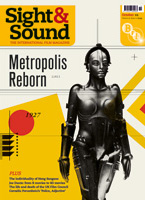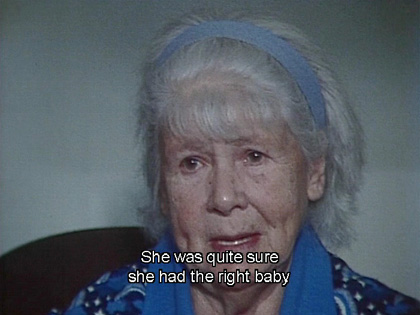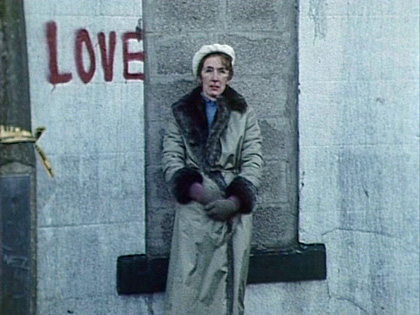Primary navigation


Françoise Romand’s inventive Mix-Up, about the families of two daughters switched at birth 21 years earlier, deserves a wider audience, says Jonathan Rosenbaum
In the interest of full disclosure, I should mention at the outset that Françoise Romand has been a good friend of mine for more than two decades. But I hasten to add that she became a friend because of my immoderate enthusiasm for Mix-Up (1986), her first film and one of the strangest as well as strongest documentaries that I know.
To make matters even more mixed-up, I should also point out that, as a bonus on the region-free DVD of this documentary, having interviewed herself in French, Françoise shows herself filming my talking-head interview (in English) while I attempt to explain why I find her film so powerful and exciting. What follows here represents another try.
Filmed over just 12 days, but recounting a multilayered real-life story that covers nearly half a century, Mix-Up relates and explores what ensued after two middle-class English women, Margaret Wheeler and Blanche Rylatt, gave birth to daughters in November 1936 in a Nottingham nursing home and the babies were inadvertently switched. The switch came about through a filing error that was only confirmed 21 years later, after Wheeler persisted in pursuing her own queasy suspicions, meanwhile keeping contact with Rylatt. But by then, of course, Peggy and Valerie had grown up with the wrong mothers, Blanche and Margaret respectively.
To take on everything this entailed, Romand enlisted all the surviving members of both families in her radical experiment, staging comic and highly stylised psychodramas about the diverse emotional histories of this colossal mishap – group psychoanalysis as mise en scène (and as découpage). “To me the cinema is a universal language,” she says in her DVD bonus interview, “because it starts from the unconscious.” And she somehow makes the whole process fun rather than ponderous, even though the emotional currents and issues about identity and destiny run as deeply and as thickly as they do in Carl Dreyer’s Gertrud (which isn’t exactly a comedy).
Because various stages in this long narrative are made to coexist in the present, the plot and characters ultimately impact with the density of a 500-page novel. And the subject is treated so exhaustively that the film’s 63 minutes register like a much longer film.
At no point, however, does Romand pretend to offer an objective, ‘balanced’ account of what happened (even though her recurring imagery, some of which is surrealist and/or allegorical, includes babies being weighed on matching scales), and the viewer is obliged to become no less invested. Margaret, an intellectual, had a lengthy correspondence with George Bernard Shaw about this case (we see the boxes of letters, but Wheeler wouldn’t permit Romand to quote from them). Yet it was clearly Valerie who grew up maimed by feeling unloved, whereas Blanche – whose matching hobby consists of collecting tiny pig figurines and cuttings about pigs and who proudly poses for us in her bowling hat – seems to have given Peggy a genuine sense of belonging.

Mix-Up has a French subtitle, Méli-mélo. My dictionary defines that as a “jumble (of facts, etc); hotchpotch; medley (of people, etc); clutter (of furniture)” – which helps to define the film’s methodology, as well as its subject. Romand’s staging and editing strategies are formal inventions involving many kinds of poetic audiovisual rhymes, employing colour, music, sound effects, domestic interiors (with windows, doors and mirrors playing framing devices) and urban exteriors (with various modes of transport predominating). There are also some Godardian juxtapositions of language and image: during walks, Valerie and Peggy each stand in front of key colour-coded words, scrawled like graffiti on peeling walls.
The intermingling of fiction and non-fiction produces many daring mixes and clashes. For example, when Martin, Margaret’s affable youngest son, crouches as an adult under a table to describe a conversation he overheard under the same table at the age of 13, the moment is uncanny. Through the ever-widening cast of relatives – ranging all the way from Margaret’s droll husband Charles (the most Dickensian character), to Blanche’s rather dour Jehovah’s Witness son Peter – a vexing moral question is repeatedly posed: the value of truth and awareness versus ignorance and innocence in living one’s life.
Rewatching Mix-Up recently, and finding it has only expanded and improved over time, I continue to wonder why it isn’t more widely known. Romand’s films, described in her self-interview, are all quite different from one another (her autobiographical Thème Je, which she calls The Camera I in English, is even more radical and transgressive than Mix-Up), giving her a somewhat elusive profile as an auteur.
But perhaps the most serious obstacle is that her masterpiece poses a genuine challenge by making art and life indistinguishable, merging artistic choices with ethical initiatives and daring us to do likewise in following Romand.
The implicit rivalry between the two mothers and their respective cultures and approaches to life is always apparent, but part of Romand’s genius is the way she gets the entire family engaged in the serious game-playing of this film’s production, a game we become obliged to play as well. This makes her art both an unpredictable, risky adventure and an unusual form of healing, for the people on screen as well as for us. The film’s hopeful closing motto – “We all belong together” – may sound a trifle optimistic but the film itself is nothing less than a multifaceted demonstration of this thesis.
“The characters are candid, intelligent and very game… they’re all a little embarrassed to find themselves at the centre of what sounds like the synopsis for a hilarious if cruel comedy. This is something that Miss Romand manages to suggest without ever condescending to her subjects or ridiculing their situation. The director and her cameraman, Emile Navarro, often photograph their interviewees in such a way that the movie looks as if it had been designed by a high-tech graphics artist. This… calls attention to the distance between the bizarre events being recalled and the perfectly rational, ordinary world in which the story was played out. At its best, Mix-Up has some of the style of Peter Greenaway’s Falls and The Draughtsman’s Contract. Mix-Up… does go on for longer than the material can easily sustain, but it’s the work of a filmmaker of original vision.”
— Vincent Canby, New York Times, 4 April, 1986
4 by Agnès Varda reviewed by Tim Lucas (April 2008)
Tell it to the camera: B. Ruby Rich on Jonathan Caouette’s “audacious autobiographical disgorging”, Tarnation (April 2005)
Capturing the Friedmans reviewed by Xan Brooks (April 2004)